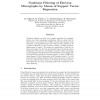Free Online Productivity Tools
i2Speak
i2Symbol
i2OCR
iTex2Img
iWeb2Print
iWeb2Shot
i2Type
iPdf2Split
iPdf2Merge
i2Bopomofo
i2Arabic
i2Style
i2Image
i2PDF
iLatex2Rtf
Sci2ools
105
click to vote
NIPS
2003
2003
Nonlinear Filtering of Electron Micrographs by Means of Support Vector Regression
Nonlinear filtering can solve very complex problems, but typically involve very time consuming calculations. Here we show that for filters that are constructed as a RBF network with Gaussian basis functions, a decomposition into linear filters exists, which can be computed efficiently in the frequency domain, yielding dramatic improvement in speed. We present an application of this idea to image processing. In electron micrograph images of photoreceptor terminals of the fruit fly, Drosophila, synaptic vesicles containing neurotransmitter should be detected and labeled automatically. We use hand labels, provided by human experts, to learn a RBF filter using Support Vector Regression with Gaussian kernels. We will show that the resulting nonlinear filter solves the task to a degree of accuracy, which is close to what can be achieved by human experts. This allows the very time consuming task of data evaluation to be done efficiently.
| Added | 31 Oct 2010 |
| Updated | 31 Oct 2010 |
| Type | Conference |
| Year | 2003 |
| Where | NIPS |
| Authors | Roland Vollgraf, Michael Scholz, Ian A. Meinertzhagen, Klaus Obermayer |
Comments (0)

